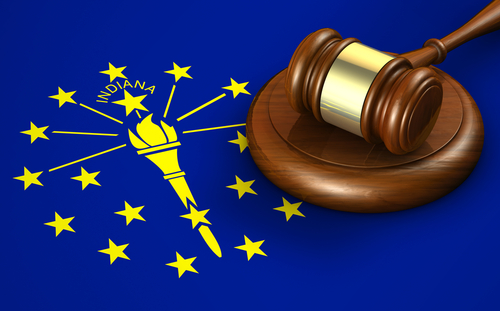Meet our 2015 Legal Rebels
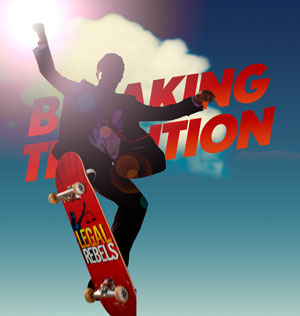
Photograph by Wayne Slezak and Brenan Sharp.
This year’s list of Legal Rebels continues our tradition of celebrating those men and women who are remaking their corners of the legal profession–finding new ways to practice law, represent their clients, adjudicate matters and train the next generation.
This year’s Rebels–nominated by our readers and staff–are a diverse group tackling many different challenges, but all using smarts and commitment to accomplish goals for practitioners and clients.
What you see in the following pages are snapshots of and brief introductions to our honorees. Go here to read their full profiles, see more photos and contribute your ideas for freeing up thinking through Box Breakers. You’re invited to take a look at past honorees at LegalRebels.com.
It’s our seventh year naming Rebels, but we know there are many trailblazers who laid the groundwork for those we honor today. In the coming months, we’ll be featuring those Legal Rebel Trailblazers in the magazine, online and in podcast interviews with the Legal Talk Network. And as for our cover art–well, we ain’t skatin’ on past tricks. Legal Rebels will always be catching air and carving out a new way.
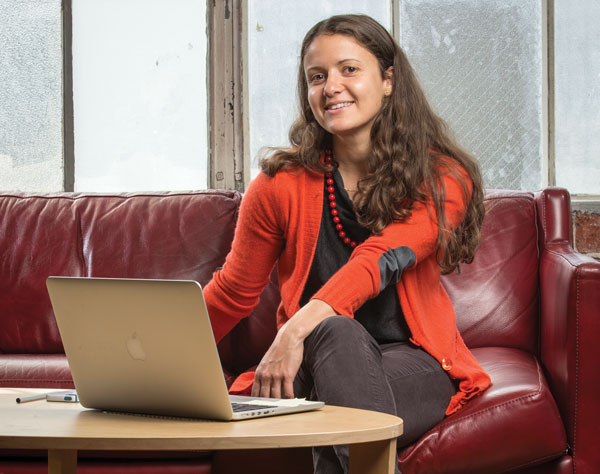
Nikki Zeichner. Photograph by Tony Avelar.
PAROLE, PRISON AND COMPILING DATA
In 2013, Nikki Zeichner was juggling two endeavors.
As a Brooklyn criminal defense lawyer, she was representing a prisoner who had been denied parole nine times and was up for a 10th (finally successful) hearing. Representing Thornwell Richburg taught her that New York parole decisions were often based on “the nature of the crime,” not anything the prisoner had done in the decades since. Partially as a result, she says, more than 10,000 state prisoners are denied parole every year at a huge human and financial cost.
“It’s just so ridiculous that you have somebody who is 50-plus years old and [parole boards are] still looking at something he did when he was in his early 20s,” she says. “It’s not recognized that somebody grows over time.”
The case also taught Zeichner, 36, where to find publicly available parole data from the state of New York. That soon became relevant to her other endeavor, as an integrated digital media graduate student at New York University’s engineering school.
Wanting to convert the data into a more usable format, she asked her adviser, R. Luke Dubois, whether it was possible to collect it from the Web. Before her eyes, he wrote a simple computer program to automate the collection.
That was the beginning of Zeichner’s Parole Hearing Data Project, a repository of public New York parole data available in easily used formats and presented online. In addition to more than 30,000 records, the project presents prisoners’ stories and parole-related legislation.
It’s integrated into an earlier project of Zeichner’s, the Museum of the American Prison, which she says is an attempt to tell stories about incarceration that don’t fit into the context of a court case.
This year Zeichner is turning her legal background and data-wrangling skills to another task: a fellowship with the nonprofit Code for America, which builds technology to make local government services easier to use.
As part of a three-person team, she’s working on tools to improve relations between the community and the police in Vallejo, California, which is struggling with the legacy of a 2008 municipal bankruptcy, a series of fatal police shootings in 2012 and a troubling crime rate.
The fellowship has taken Zeichner, a New Yorker since 1997, across the country to the San Francisco Bay Area. While she loves and misses New York, she says it’s exciting to live somewhere new.
Though Zeichner still practices law as a solo, her career has taken her far from the conventional path of a law school graduate. Inspired by an early job with a creative consumer attorney and then again at the public interest-focused City University of New York School of Law, she says she was always interested in people and problem-solving.
“I guess I always had an idea that I wanted to be creative,” she says, “however I ended up using the law.”
—Lorelei Laird
Click here to read an extended profile of Nikki Zeichner.

Shantelle Argyle and A. Daniel Spencer. Photograph by Benjamin Hager.
MAKING HAY THE NONPROFIT WAY
The words nonprofit and law firm don’t usually go together. But Salt Lake City attorneys Shantelle Argyle and A. Daniel Spencer saw no reason why they shouldn’t. “One thing people don’t understand about nonprofits is that they’re ubiquitous,” says Spencer, who along with Argyle started Open Legal Services in the fall of 2013. “We don’t know why people don’t typically think of nonprofit and law going together. Is it because of tradition or lack of understanding? Who knows?”
Argyle, 34, and Spencer, 33, met as students at the University of Utah’s S.J. Quinney School of Law. When they graduated in 2013, the job market was still below pre-recession levels, and competition for public sector jobs in Salt Lake City was tough.
“Dan was a former financial planner, and it was his idea to set up the firm as a nonprofit,” says Argyle. “It’s been done in medicine and finance, so we decided to try it for law.”
The advantages of nonprofit status for lawyers are numerous, as can be seen on the Open Legal Services website. They are eligible for the federal Public Service Loan Forgiveness Program, they pay less in taxes, they can solicit donations and recruit volunteers, and they can receive referrals from courts and other nonprofits that might not be allowed for for-profit firms.
Open Legal Services does not offer free legal services. Instead, the firm keeps its hourly rates low: A single parent with one child and an income of $24,000 per year would qualify for an hourly rate of $65, while a family of four bringing in $47,500 annually could pay as little as $95 an hour.
Argyle and Spencer say the firm, which consists of four other attorneys, one paralegal and an assistant director who has a business background, keeps its rates low through a combination of in-kind donations and lean overhead. And the firm’s attorneys boast a wide range of skills that allow Open Legal Services to keep many matters in-house.
“Rather than hiring IT and finance people, we can do that ourselves,” says Argyle, who has a background in computer technical support. “Some firms that have a low-overhead model can’t do this.”
Argyle and Spencer hope to continue strengthening the link between nonprofits and law firms.
“The biggest thing is goodwill,” says Spencer. “By being a nonprofit, we’re not here to make lots of money. We have an incentive to actually provide efficient service and the best service possible at the lowest price.
“As a nonprofit,” he says, “we are not presumed to be just another law firm.”
—Victor Li
Click here for an extended profile of Shantelle Argyle and A. Daniel Spencer.
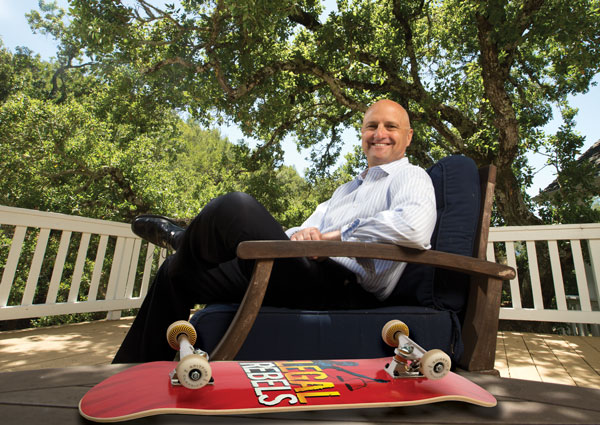
Ray Gallo. Photo Illustration by Tony Avelar and Brenan Sharp.
MANAGING MASS ACTION
Ray Gallo was getting clients he didn’t even know he had.
In late 2008, Gallo’s San Rafael, California, law firm was spearheading Amador v. California Culinary Academy, a putative class action alleging that a Bay Area culinary school misled its students about their job prospects. The plaintiffs argued they were promised high-profile chef jobs; they typically got barista jobs and high student loan debt.
The initial group of claimants was fairly small, Gallo says, but that was before a client put information about the case online. Soon, Gallo LLP was receiving signed fee agreements from people Gallo had never spoken to. And that spelled trouble—not only because he preferred to know who his clients were, but also because class certification seemed unlikely. Because mass actions, in which numerous plaintiffs pursue similar cases against the same defendant, create a lot of administrative work, they’re often unprofitable for law firms unless the damages are quite large. That’s one reason class actions, in which one plaintiff stands in for a large group, are more common.
But a series of U.S. Supreme Court decisions have made class actions harder to certify. And individual claims have lots of advantages over class actions, Gallo says: It’s OK if the facts vary from plaintiff to plaintiff, plaintiffs can claim emotional and punitive damages, and one loss doesn’t end the case for everybody.
That’s why Gallo, 50, created Leverage, a Web-based app that automates much of the administrative work of mass actions. Leverage handles client sign-ups, initial interviews, document requests, communication and more.
“Forget the class action,” he says to potential opponents. “I’m going to bring 1,000 individual claims. I’m going to bring 10,000 individual claims and you’re going to wish it was a class action, because you were better off.”
Gallo says that Amador settled right after the Leverage prototype was done, and that its existence was key to the settlement. He got a chance to really put the app through its paces with Vasquez v. California School of Culinary Arts, a similar lawsuit in Los Angeles.
His co-counsel on Vasquez, Michael Louis Kelly, says Leverage was “very advantageous” over clerks with telephones, in part because of the clients’ circumstances.
“A lot of our clients were … working two or three jobs trying to make ends meet, and it would be a week or two weeks before we could get them on the phone,” says Kelly of Kirtland & Packard in El Segundo, California.
“And a lot of them wouldn’t answer their phones because most of their phone calls were from bill collectors. A lot filled out forms at 2 or 3 in the morning.”
“This is a huge access-to-justice opportunity,” he says. “This tool makes what could be billions of dollars of claims remediable, every year, that currently go unasserted because there’s no practical way to handle them.”
—L.L.
Click here for an extended profile of Ray Gallo.
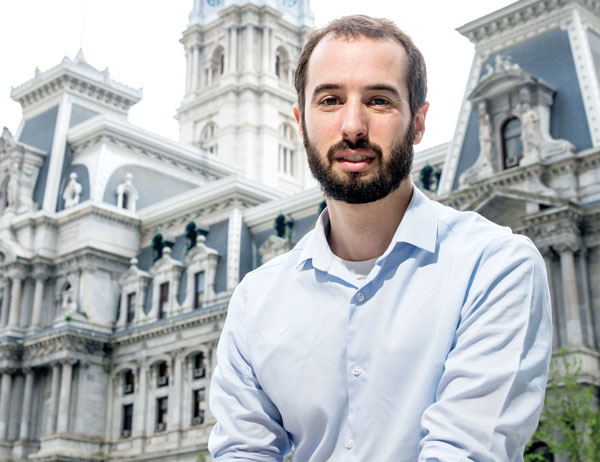
Michael Hollander. Photograph by David Fonda Photography.
CLEANING RECORDS BY THE THOUSANDS
Many might see life as a software developer in San Francisco as a job with a future (if not a fortune). But it wasn’t enough for Michael Hollander.
“I enjoyed the work that I did, but I was solving problems to help businesses do business better,” says Hollander. ”I wanted to do more to help my community.”
Today, Hollander, 36, is a staff attorney at Community Legal Services of Philadelphia. For his day job, he provides employment law services to indigent clients. And he is using his developer skills to modernize pro bono legal services for low-income Philadelphians.
“I tend to be extraordinarily practical with the tools I’m making,” he says, noting that when he experiences “pain or boredom by the repetition of this work,” he starts looking for new ways to do the task.
Repetition-induced boredom was Hollander’s motivation for building a digital expungement generator. Both his office and Philadelphia Lawyers for Social Equity—a legal services provider Hollander helped co-found—use the generator to convert an electronic version of a client’s criminal record to an editable and near-file-ready document.
“The generator cuts our petition-drafting time by two-thirds, from three hours to one,” says Mike Lee, PLSE’s director. The generator has helped his office file nearly 4,000 expungements, 92 percent of which have been granted.
The First Judicial District in Philadelphia has felt the effect of the app. Keith Smith, director of active criminal records for the criminal trial division at the court, says he’s seen expungement filings increase significantly. In 2010, the year before the app was first used, the court saw 4,430 expungements filed. The year after the app’s release, 2012, saw expungement filings jump to 8,125; in 2013, there were 6,003.
While the expungement generator has created interest amongst other legal service providers in Pennsylvania and around the country, it is not Hollander’s only legal tech project. He also created a data-collection tool that helped forgive bail judgment debt for thousands of Philadelphians.
Hollander says his ability to create new tools comes from working at an office where his colleagues support him.
Sharon Dietrich, the litigation director at Community Legal Services and Hollander’s boss, is happy to provide him the space he needs to explore new ideas.
“We need to do more with less, and technology can be part of the answer to that,” Dietrich says. “We can reach many more people with the same number of attorneys.”
Hollander and his wife, Beth, an architect, both work in demanding professions, but he proactively seeks a healthy balance, especially since becoming a father. This has meant forgoing evening work events to have more time to spend with his 2-year-old daughter, Esme.
Hollander’s use of technology and the impact of his work have broader implications to the legal profession. And he is optimistic, while acknowledging that technology will change what it means to practice law.
“Lawyers are smart and enterprising,” he says. “They will certainly find a way to land on their feet.”
—Jason Tashea
Click here to read an extended profile of Michael Hollander.

V. David Zvenyach. Photo Illustration by Arnold Adler and Brenan Sharp.
TRUE TO TRANSPARENCY
A lot of public sector lawyers talk a good game when it comes to promoting transparency and open government. For V. David Zvenyach, former general counsel for the Council of the District of Columbia, it’s been his calling card.
Zvenyach, 33, served as the council’s GC from April 2011 until March. Midway through his tenure, he learned legal hackers in D.C. were upset that there wasn’t a free, accessible electronic version of the District of Columbia Code. The legal hackers hoped to use a digital copy to create websites and apps that would allow users to have a better understanding of local laws.
Copyright was behind the reason no electronic version was available. The official code was published initially by Westlaw and subsequently by LexisNexis, and their annotations and citations were protected as intellectual property.
Zvenyach, however, recognized the value of an informed citizenry. “I was enthusiastic that people were interested in the code itself,” he says . “It’s not often that you get a lot of people talking about our legal documents.”
Zvenyach stripped out all the copyrighted annotations and citations in the D.C. Code and put the unofficial code online. He even invited members of the civic hacking community to play with it, and he found himself learning how to use computer programming code.
“In my own experience,” he says, “the moment the D.C. Code was in searchable form, I found myself using it more, and on a daily basis.”
Zvenyach had little background or history with computers when he enrolled at the George Washington University Law School in 2003. His bachelor’s degree was in mechanical engineering, and he came to law school to be a patent attorney. Instead, he joined the D.C. government in 2008 after a two-year federal clerkship and served as chief of staff to D.C. Council member Mary Cheh, his former professor at GW.
For Zvenyach, what started as a casual foray into coding has turned into a career. He left the D.C. Council in March to join 18F, a digital services agency based within the federal government’s General Services Administration. The 18F agency designs digital products for government organizations and utilizes open-source code.
Zvenyach says the agency gives him a chance to be a professional legal hacker. “What’s really exciting about 18F is that we’re embracing the legal hacker culture,” he says. “The government is bringing in people from outside who just want to get in and fix things.”
Jonathan Willingham, a law school classmate who succeeded Zvenyach as Cheh’s chief of staff, says 18F is perfect for Zvenyach.
“Dave has always had an interest in law, accessibility and modernization,” Willingham says. “He also has this tech side that he didn’t always get to express. This is a way for him to bring all of these interests together.
“At a time when the government is interested in doing things better and saving money, there’s all kinds of amazing things he can do that will benefit everyone in the government.”
—V.L.
Click here to read an extended profile of V. David Zvenyach.
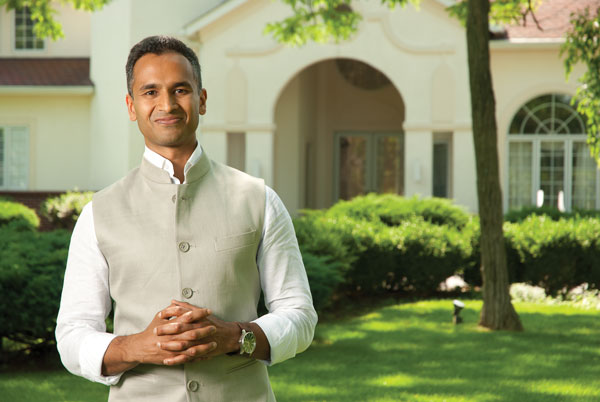
Vivek Maru. Photograph by David Mudd.
DRAWING THE ARC TO GLOBAL JUSTICE
After finishing at Harvard College and before entering Yale Law School, Vivek Maru, born and reared in the U.S., took off more than a year to live in a hut made of sticks and dung amid the poverty and pollution of India’s Kutch region, from which his grandfather came. Maru worked with grassroots organizations on watershed management and education for girls.
Daily he saw village women walk a mile and a half to fetch drinking water with clay pots balanced on their heads. His return to the U.S. was jolting: “In the law school cafeteria, I would press a little button to get juice and pink stuff flowed out. I felt vertigo in the transition coming back.”
Maru, 40, has made a career dealing with transition, helping locals in Africa and Asia as developed nations compete in a global land rush to gain use of natural resources in less-developed areas. In 2011 he founded an organization called Namati, which now works in eight countries, primarily developing cadres of paralegals to bring legal empowerment at the community level.
The issues are wide-ranging: seeking proof of citizenship or deeds of title for family property; gaining legal rights for women while navigating gaps in plural legal systems that can include statutory, customary and religious law; and being thrust suddenly into lopsided negotiations with megacorporations wanting their way with the land.
Namati is a Sanskrit word meaning to shape something into a curve, and its choice was based on Martin Luther King Jr.’s remark that the “arc of the moral universe is long, but it bends toward justice.”
A friend invited Maru in 2003 to help Sierra Leone recover from its 11-year civil war. They co-founded Timap for Justice, which became a template for Namati. Timap developed a network of paralegals around the country—which had a plural legal system—to address two of the biggest causes of the upheaval: arbitrary governance and maladministration of justice.
“Paralegals working and living in the community can squeeze a lot of justice out of the system,” says Maru, who committed to one year in Sierra Leone but stayed four. Operating in communities in Kenya, Liberia, Mozambique, Sierra Leone and Uganda in Africa and in Bangladesh, India and Myanmar in Asia, Namati has 88 paralegals at work, with some lawyers they can turn to when needed. They are part of a growing global network for legal empowerment that now includes 450 organizations.
Says Matt Brown, Maru’s Yale Law School classmate and a member of Namati’s board: “What makes it hard, interesting and ultimately important is Vivek and Namati are creating a new field of legal empowerment, partly by running programs that are models, and partly by strategically stitching together many organizations and activists around the world into a global force for solving some of the big problems.”
—Terry Carter
Click here for an extended profile of Vivek Maru.
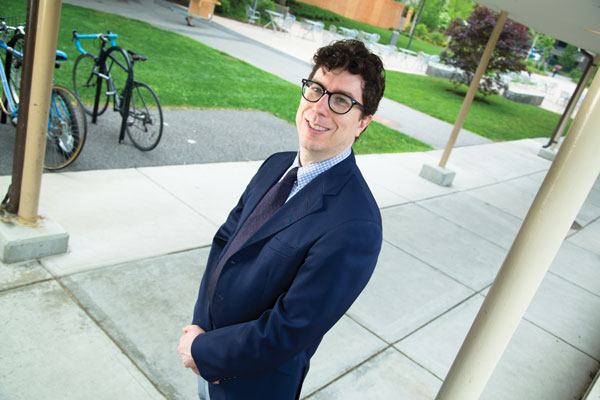
Jonathan Zittrain. Photograph by Arnold Adler.
SAVING LINKS FOR POSTERITY
Sure, it’s annoying when you click on a link and get that “404” message or an automatic redirect to the homepage. But when it comes to legal research, dead links aren’t just annoying; they can undermine the entire premise of an opinion, article or treatise.
Hoping to end this type of “link rot,” Harvard University Law School came up with Perma.cc—an archival tool that allows users to submit their links to Harvard’s library to be permanently preserved.
The idea was the brainchild of Jonathan Zittrain, a professor of international law who became director of the Harvard Law School Library two years ago.
Zittrain, 45, had co-authored a paper with fellow Harvard Law professor Larry Lessig and then-student Kendra Albert that found half of the links cited in U.S. Supreme Court opinions and nearly three-fourths of links cited in law journals no longer worked properly.
“Link rot is especially worrisome when it comes to judicial opinions and scholarship,” Zittrain says. “If you can’t see what’s being linked to, then it makes it hard to give credit to what you’re reading.”
Zittrain’s digital street cred is as powerful as his law school position: He is also a professor of computer science at Harvard and a co-founder and faculty director of the university’s Berkman Center for Internet & Society.
Zittrain’s paper proposed the implementation of Perma.cc, a service that allows authors to submit their links for archiving.
Perma.cc takes screenshots of the linked documents and keeps them stored on its servers so there’s always a permanent record. Using a Perma link, a viewer can link to a current-day version of the webpage if it is still available. If not, a tab links to a screenshot of the page as it was when it was submitted. Another tab links to an archived HTML version of the page.
In 2013 the Harvard Library Innovation Lab, under the directorship of Kim Dulin, launched the service based on Zittrain’s proposal.
“We created the Harvard Library Innovation Lab to create things in the virtual Internet world that work well for libraries,” Dulin says. “When Jonathan came up with the research and showed us all this link rot, we thought we could do something about it.”
Though most documents archived on Perma are publicly available, the service has its dark side—a Dark Archive that stores documents the submitter wants kept permanently but not widely available. The service presents a black lightbulb to viewers who link to such a site, telling them to “contact a librarian to get a copy.”
Project manager Adam Ziegler would like to see the rest of the law libraries in the United States, as well as those overseas, adopt Perma.cc.
“Part of our challenge is to help educate people about link rot,” Ziegler says. “I’ll ask people what do they do now to avoid link rot, and they’ll just sheepishly say that they aren’t doing anything.”
—V.L.
Click here to read an extended profile of Jonathan Zittrain.
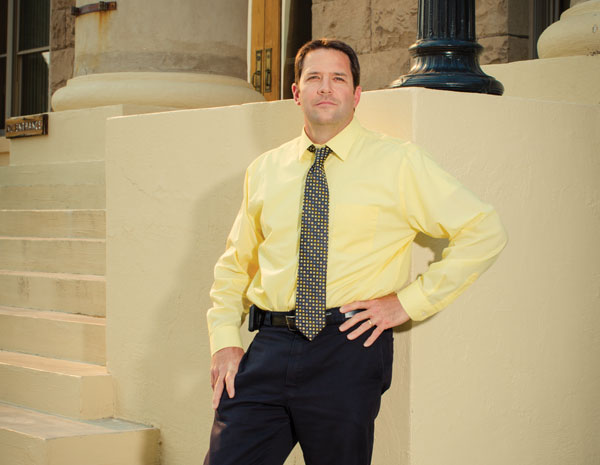
Kyle Rimel. Photograph by Jeff Green Photography.
USING TECH TO SPAN CANYONS
If you lived in far northwest Mohave County, Arizona, it might take more than an hour to get to the nearest court building in Colorado City, and you’d have to drive into Utah to get there. Residents of the area, called the Arizona Strip, are cut off by the Grand Canyon, the Colorado River and the Virgin River Gorge.
So in 2013 the Mohave County Superior Court IT staff, led by court technology systems manager Kyle Rimel, 45, created a remote kiosk with video chat access for those residents. Known as the North County Kiosk, it’s at the state department of motor vehicles’ Beaver Dam office, about 70 miles from Colorado City’s North Canyon Consolidated Court.
The kiosk can access any of the county’s courtrooms, and users can make court appearances, pay fines, get forms and make filings through it.
Another technology project at the superior court is courthouse posters with bar codes that smartphones can scan, providing access to jury and divorce information, calendars and physical directions.
There’s also an Internet chat line staffed by court employees, and Rimel and his staff installed and maintain audio-video equipment with push-button controls in 19 courtrooms. If they had hired an outside vendor, Rimel says, installation fees would have cost approximately $20,000 per courtroom.
“We like to think of ourselves as an innovative court, and we’re really excited about moving forward,” he says. “Our goal is to be one of the most technologically advanced courts in Arizona.”
Aside from 2 years in Memphis, Tennessee, where he worked for the information technology outsourcing company Affiliated Computer Services, Rimel’s entire career has been in Mohave County. When he started working for the court in 2003, its IT department only had one computer server and a part-time employee.
“I was surprised to see how little technology made its way into the court system,” Rimel says. “They were really excited to get their calendars on the Internet.”
Today the department has 10 servers and four full-time employees, including Rimel, who describes the court as “one of the best places I have ever worked.”
Rimel, a Kingman native, and his wife, Jennifer, don’t seem daunted by big tasks. They live in the Hualapai Mountains in the second home they built themselves. They started on their first home when he was 18 and she was 17.
Rimel’s family has been involved in team roping, and he still enjoys the rodeo sport. It involves two people on horseback, working together to rope a calf as quickly as possible.
Team roping and IT work have few similarities, Rimel says, but the commonality seems significant.
“I cannot think of anything that would correlate between the two,” he says, “other than possibly awareness and a level of common sense that is needed in both areas.”
—Stephanie Francis Ward
Click here for an extended profile of Kyle Rimel.
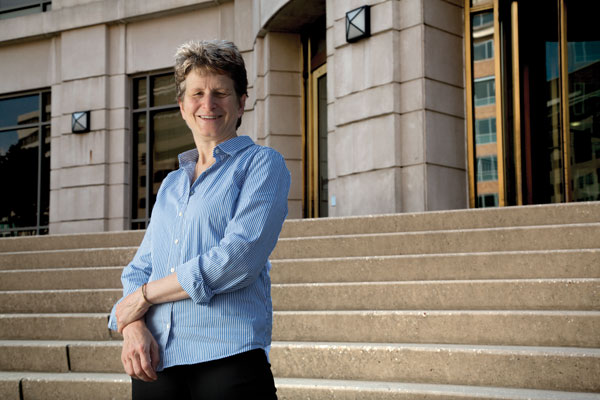
Tanina Rostain. Photograph by Arnold Adler.
A2J APP-PLICABLE LEARNING
Professor Tanina Rostain has made a 180-degree turn in her work on the ethics of lawyering. For nearly 20 years she pushed to reform organizational pressures that increasingly had lawyers bending and breaking rules on behalf of corporate clients. (Think dodgy tax shelters.) Now she’s focused on the essence of law as an institution that is supposed to help people. (Think access to justice.)
“I still teach legal ethics, but now the focus is different,” says Rostain, co-director of the Center for the Study of the Legal Profession at Georgetown University Law Center.
Rostain developed and teaches the course “Technology, Innovation and Legal Practice.” It has seen stunning growth in just four years, with students engaged in hands-on development of apps that render areas of the justice system accessible to one and all.
The course is built around a competition among four teams of three or four students designing and developing apps that consumers, nonlawyer advocates and public interest lawyers can use to navigate complex areas of the law. The teams use the Neota Logic platform that enables those who are not fluent in computer coding to create software and websites.
Initially those teams in the Iron Tech Lawyer: Access to Justice Edition competition had no real expectation that legal services organizations and others might adopt their apps. But when word got out, specific requests flowed in.
Now, organizations ranging from the U.S. Department of Justice to the Alaska Legal Services Corp. send in requests and consult with the students on the projects. For the Justice Department, a team of students developed ADA2Go to help people with disabilities, those working on their behalf, and businesses and organizations subject to the Americans with Disabilities Act to ascertain their rights or responsibilities in specific situations.
But the scope of the class isn’t restricted to helping those who are unable to afford lawyers. A student in that initial Iron Tech competition in 2012, Dustin Robinson, immediately took a job in Chicago as a legal solutions architect with SeyfarthLean Consulting, a subsidiary of the Seyfarth Shaw law firm. “I’m sort of a liaison between lawyers and software developers because I speak enough of both languages,” Robinson says. In each of the past two years, an Iron Tech student followed him there.
The Iron Tech apps don’t test users for income level unless it is pertinent to the solution. So Rostain thinks they will have more impact on the profession (especially on solo and small-firm lawyers) than many realize.
“These apps are adaptable to a lot of paying legal work, and they’re going to proliferate,” Rostain says. “I think they’re really going to shake up the market.”
—T.C.
Click here for an extended profile of Tanina Rostain.
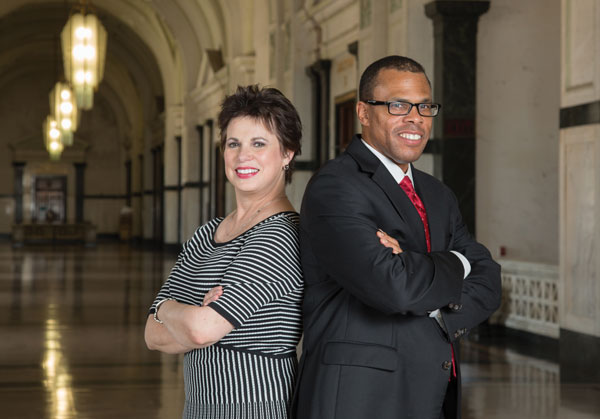
Laurie A. White and Arthur Hunter Jr., Photograph by Kathy Anderson.
HAVING LIFERS TEACH LESSONS
Life in the Louisiana State Penitentiary—aka the fearsome Angola prison—can seem so daunting that it barely qualifies as living.
But two state parish judges, Laurie A. White and Arthur Hunter Jr., both 56, have helped create a program that gives purpose, value and meaning to that time for Angola’s lifers and inmates serving less severe terms.
She, a former prosecutor, and he, a former New Orleans police officer, founded the Orleans Re-entry Court Workforce Development Program. It relies on men serving Angola life sentences to teach new inmates—most of whom come in with 10-year sentences—GED classes and job training in skilled trades like plumbing and carpentry. Prison officials manage the program and select life-sentence inmates they trust to do the teaching.
Life skills, including anger management, parenting and character, are also taught by men serving life sentences. Hunter refers to them as mentors.
“From what the mentors tell me, these guys come in straight off the streets of New Orleans and they think it’s a hustle—go in, do the time and get out,” Hunter says. “The mentors tell them that it’s not about that, and they basically teach the young ones, who usually haven’t had any role models, that street life is not good.”
According to Hunter, 70 percent of released inmates who finish the program successfully reintegrate into society. He hopes those who complete the program will one day have their own businesses.
“I tell people that I want to make these guys into taxpayers. They’re now tax takers,” Hunter says. And White observes: “When you throw people away with a life sentence with no possibility of parole, people still do good things for themselves.”
Participants can win early release once they complete the program, which can take two years. They then serve five years’ probation.
Former lifers who have worked in the program have their own assessments of its success.
“For the lifers,” says Calvin Duncan, a former Angola inmate and jailhouse lawyer who taught GED and law classes while serving his sentence, “this gives them a chance to show themselves that they would have made it on the streets, and society was wrong when [it] threw them away.”
Judge Hunter is a New Orleans native whose father owned a grocery store in the city’s 9th Ward. Judge White grew up in Baton Rouge. As a child she spent summers at her father’s farm, where he grew soybeans, cotton and peaches.
And while Hunter moved from police work to private practice to a judgeship at age 36, White went from being a prosecutor to private criminal defense work and handled post-conviction appeals for many Angola inmates.
“That was really the only work I could get,” she says. “No one was going to hire a white woman named White to do their criminal defense work.
“I learned that people who were doing a life sentence had so much to offer, and I wanted to tap into this resource,” she says. In fact, Duncan is a former client.
Hunter encouraged her to run for the judgeship she won in 2007.
Ronald S. Sullivan Jr., a Harvard Law School professor who led and reorganized the Orleans Public Defenders Office for a year following Hurricane Katrina, describes Hunter as a fearless jurist who will use his authority for justice.
And sometimes White’s empathy with Angola inmates surprises people, given her life experiences.
“Laurie White is a very attractive white woman who grew up in country Louisiana. She didn’t come as a poor woman; she came from wealth,” says Calvin Johnson, a retired Orleans Parish judge who created the state’s first mental health division. “She became an advocate for individuals who were African-American more than anything else, who’ve been mistreated by the system, and she saw it.”
—S.F.W.
Click here for an extended profile of Laurie White. Click here for an extended profile of Arthur Hunter Jr.
Correction
The print and the initial online version of the Legal Rebels profile “Making Hay the Nonprofit Way,” September, should have stated that Open Legal Services keeps its rates low through a combination of in-kind donations and lean overhead. The firm does not accept grants. It also should have stated that Open Legal Services was founded in the fall of 2013.The print and the initial online version of the Legal Rebels profile “Managing Mass Action,” September, should have said the Leverage app was ready just before Amador v. California Culinary Academy settled. Ray Gallo says the app was key to the settlement.
The Journal regrets the errors.

